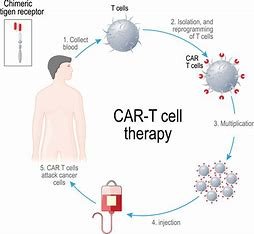“Explore the groundbreaking advancements in CAR T cell therapy and immunotherapy, highlighting key challenges in the development, testing, and safety of these treatments.”
CAR T cell therapies have given rise to unprecedented enthusiasm, and hope among investigators, practitioners, and patients. The efficacy of CAR T cell therapy in early clinical trials has been remarkable, and multiple CAR T cell therapies have been approved for selected hematological malignancies. With high response rates and even possible long-term remission, these therapies also offer hope for patients who have already experienced failure of standard treatment options.
Immunotherapy
Immunotherapy has made significant advances, especially in the last few years and these have changed the paradigm of cancer treatment. One of its promising innovations is the Chimeric Antigen Receptor T-cell (CAR T cell) therapies. These theranostics utilize the T cells of individual patients genetically engineered to express CARs, enabling a patient’s own immune system to fight cancer. These CARs allow T cells to selectively bind and kill, making them a precise and effective therapy against cancer.
Despite the intriguing results of CAR T cell therapies in early phase clinical trials, the development and administration of these products presents challenges that require extensive analytical testing. Analytical testing supports the safety, quality and efficacy of these new therapeutic modalities. Regulatory agencies, like the U.S. Food and Drug Administration (FDA), have emphasized that thorough analytical testing is needed to ensure that key characteristics such as identity, potency and most importantly safety are established for these products.
Need for early assay development and validation
The complexity of CAR T cells and the different mechanisms underlying their therapeutic activity necessitates the need for product-specific biological assays. Just like any other therapeutic product, there is a necessity to start early the continuous development of the assay for it to pass timely through preclinical studies and clinical trial. Looking further down the development pipeline, if assay development is postponed until later stages of development, it can cause a significant delay in assessing these therapies and avoiding a potential life-saving treatment to patients.
Assay validation
It is a key part of analytical testing that supports the validity and reliability of test results. Phase 1 studies do not usually require formal validation, yet presenting data showing proper control of the methods used to test them is advisable. This allows researchers and sponsors to reassure the scientific community and regulatory agencies of clinical studies, which can help the studies move forward.
In order to comply with scientific principles, analytical assays must be specific, sensitive and reproducible. This involves choosing which controls and standards to use for getting accurate, repeatable results from the tests. Where appropriate and from a scientific point of view methods are available, compendial methods should be used and tests in relation to safety need to have an adequate qualification before clinical studies can start.
With the progression of CAR T cell therapies along the development pipeline, each assay should be qualified according to their individual stage-specific needs. Assays that are meant to provide responsible first-line evidence of effectiveness in support of a marketing application, for instance, will need a more rigorous qualification. Assays should also be validated for a Biologics License Application (BLA) to provide evidence of safety and efficacy prior to market access.
Flow Cytometry – The Swiss Army Knife for CAR T Cell Characterization
Flow cytometry is one of the most powerful and dynamic techniques used in phenotyping CAR T cells among various other analytical strategies. Flow cytometry allows for multi-parameter analysis, which provides essential information regarding numerous features of CAR T cells at various stages during the manufacturing process. Essentials like cell viability, identity, purity and potency can be assessed using flow cytometry which are very important parameters for the quality control of CAR T cell based therapeutic products.
Flow cytometry assays should be developed on scientifically sound principles to yield robust and reproducible results. When adequately validated, flow cytometry assays can produce reliable, reproducible data on the attributes of CAR T cells that will enable rational preclinical and clinical decisions to be made.
A description of the flow cytometry assay should be provided in detail for an application to support the original submission of an IND. Such a description should contain information regarding the antibody panel and gating strategy utilized to characterize specific cell populations, in addition to outlining whether live/dead staining was performed for relevant cell populations to be incorporated within the final product. Accurate and reproducible flow cytometry data require strong instrument calibration and quality control practices.
Flow cytometry
Flow cytometry relies heavily on assay controls to obtain accurate data. Compensation controls are measures for calculating compensation values to minimize the unwanted impacts of spectral overlap between two or more fluorochromes on data interpretation. Specifically, FMO controls facilitate identification of fluorescence spread and (due to smears containing minor populations) gating boundaries, while isotype control aids the assessment of nonspecific binding.
Beyond assay development, the consideration of proper staining/ acquisition and data analysis procedures play an important role in ensuring that high quality data can be generated. Written procedures should be documented and followed to ensure uniformity and consistency between laboratories and users.
Flow cytometry is primarily used for CAR T cell analytical testing based on the direct detection of the CAR. Yielding what proportion of CAR-positive cells expresses an important measure of the success of CAR T cell production. When a surrogate marker is used for detection of CAR expression, sensitivity and specificity should be shown for the surrogate marker to ascertain that it can act as an appropriate substitute for direct CAR detection.
Guidelines for these tests are presented by the International Conference on Harmonisation (ICH) and indicate that a thorough validation study, particularly for lot release flow cytometry should be pursued.
Validation study:
Every fluorescently labeled marker in the flow cytometry panel must be validated on the flow cytometer(s) where CAR T cells will be released. Another important part of the validation process are robustness studies, in particular by establishing the maximum holding time for samples between sampling and staining and then between staining and acquisition. In addition, training records of all personnel who conducted the validation studies should be kept for assay consistency and reproducibility.
Decoding Vector Copy number (VCN) for improved safety
One critical component of CAR T cell analytical testing is the determination of Vector Copy Number (VCN), which calculates the average number of transgene integrations per CAR positive cell. The integration of transgene in CAR T cells can modulate expression of cellular genes and even provide oncogenicity. Hence, it is crucial to evaluate the VCN for the safety of CAR T cell therapies.
Then the VCN can be calculated as a function of CAR-expressing cells, which gives an accurate estimate of VCN in transduced cells and helps for getting insight about the risk of insertional mutagenesis. With the advancement of CAR T cell therapies in clinical development, establishing a VCN release criterion is important for defining product specifications and maintaining consistent quality of the product.
VCN release criteria
The VCN release criterion is empirical and rationalized based on detailed risk assessment. Any source of data contributing to this risk assessment (e.g., insertion site analysis, clonal dominance, dose-response relationships, indications and characteristics of study populations) would be subject to one or more assessments as described above. Experimental data to support this risk assessment and VCN release specifications can be derived from several engineering manufacturing runs.
In some cases, especially for extended culture-free manufactured CAR T cells, measurement of stably integrated VCN at the time of lot release testing may not be possible due to the presence of non-integrated episomal vectors. In these situations, interim VCN evaluations at the point of lot release, followed by later measurement of stable integrated VCN in cultured CAR T cells may be required for accurate assessment.
Testing Identity: A test for ensuring an object is specific the same instance.
Identity testing is an essential part of CAR T cell analytical testing which is required at all phases of development and for licensure. Test of identity is conducted to correctly identify a CAR T cell product and differentiate it from other products produced in the same site. Identity testing should be established and applied with extreme stringency to ensure the authenticity and integrity of CAR T cell modalities.
T testing of the identity element for CAR T should have assays for transgene presence (CAR expression by flow cytometry or gene detection by PCR). Alternatively, assays targeting the cellular content of the final product such as cell surface markers should be assessed. This grouped assay approach allows the confirmation of CAR T cell identity to be performed with a confidence that exceeds any singular assay.
Note that for autologous CAR T cells, HLA typing may also be done. Nevertheless, this only constitutes an external identity test since HLA typing is unable to identify the genetic modification established by CAR expression. Thus, there is no way to replace the need for maintaining chain of identity as origin of CAR T cell therapies must be consistently ensured and traceable, which requires HLA typing.
Evaluating Potency: How They Work.
Potency is a key factor on the therapeutic action of CAR T cell therapies. CAR T cells mediate their therapeutic activity via multiple mechanisms of action including direct target cell killing, secretion of activating and regulatory cytokines, and by stimulating other immune effector cells. Therefore, a full potency analysis is obligatory for precisely assessing the therapeutic potential of CAR T cell therapies.
The potency measurement is suggested to be a matrix approach with the parallel measurements from orthogonal methods to evaluate distinct functional attributes of CAR T cell. Such a strategy could utilize cell killing assays to determine the efficacy of CAR T cells in destroying target cells, transduction efficiency measures to assess gene transfer success and cytokine secretion assays to quantify the immunomodulatory capacity of CAR T cells.
Conclusion
For multi-transgene CAR T cells, each active component of the transgene should have a separate potency assay to evaluate it individually. If the CAR T cell contains other independent transgenes (e.g., cytokine transgenes as well as a CAR), separate potency assays should be developed to measure the activity of each functional component independently.
BioBoston Consulting is here to help your organization reach its full potential, contact us today or browse our website for further details!


